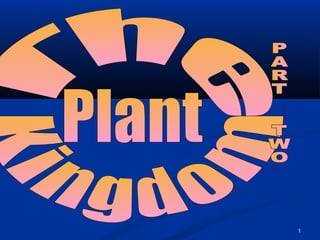
14 plant kingdom_part_two (1)
- 1. 1
- 2. 2 Main Types of Plants 1) vascular 2) nonvascular PLANTS Vascular Nonvascular Mosses & liverworts Nonvascular- plants that lack tube-like cells and do not have “true” roots, stems, & leaves •Also called bryophytes 2
- 3. 2 Main Types of Nonvascular Plants A small simple nonvascular plant that 1) moss- has both stems and leaves…but NO ROOTS •Mosses are considered nonvascular and are grouped with liverworts because: a) their vascular (inner) tissue is very simple b) they both have similar life cycles 3
- 4. Nonvascular Plants: Moss Characteristics of Moss: •fine soft stems •grow upright in “mats” •leaves are only one or two cells thick •leaves grow from all sides of the stem •moss species can be classified by their leaves based on: a) Placement of leaves on the stem b) Shape of leaves 4
- 5. Nonvascular Plants: Mosses 4 uses of mosses 1) Food for animals EX: worms & snails eat moss 2) They help hold soil in place to keep it from washing away 3) Some mosses live on rocks and break them down moss that is added to soil 4) Peat to increase the amount of moss- water it holds 5
- 6. Nonvascular Plants: Mosses Moss Life Cycle Sexual reproduction- •form a new organism by the union of 2 reproductive cells 1) female reproductive cell EGG 2) male reproductive cell SPERM •Both are located at the tips of the mosses leafy stem fertilization •the joining of the egg and the sperm 6
- 7. Nonvascular Plants: Mosses Moss Life Cycle •sperm and egg of mosses form at the tips of the leafy stems •sperm of mosses and liverworts must swim to the egg for fertilization 1) fertilization 2) A stalk grows from a fertalized egg 3) Brown capsule forms at the end of the stalk (stem) 4) Brown capsule contains spores 5) Spores are blown away from parent plant… by wind 6) They land and grow into new leafy plants 7
- 8. 2 Main Types of Nonvascular Plants A small simple nonvascular plant 2) liverwort- that do NOT have roots, stems, or leaves •H2O and other materials are distributed throughout their bodies by: a) osmosis b) diffusion 8
- 9. Nonvascular Plants: liverworts General Characteristics facts about liverworts 1) simplest nonvascular plant 2) flat body 3) slippery layer of green cells on the ground 4) leaves grow in 2-3 flattened rows along the stem 9
- 10. What two types of nonvascular plants are shown on this rock? 1) Moss 2) Liverwort 10
- 11. Slide Questions Part Two (slides 27-36) Directions: Answer the following questions. 1) List the main types of plants 2) Define nonvascular. 3) Define moss and list 3 of the 5 main characteristics of mosses. 4) Why are mosses considered nonvascular if they appear to have a stem and a leaf? 5) List the two ways that moss species are classified. 11
- 12. Slide Questions Part Two (slides 27-36) Directions: Answer the following questions. 6) List the 4 uses of moss. ) Explain how mosses reproduce. 8) Define fertilization. 9) Define liverwort. How so they take in water? 10) List two of the four characteristics of liverworts. 12
